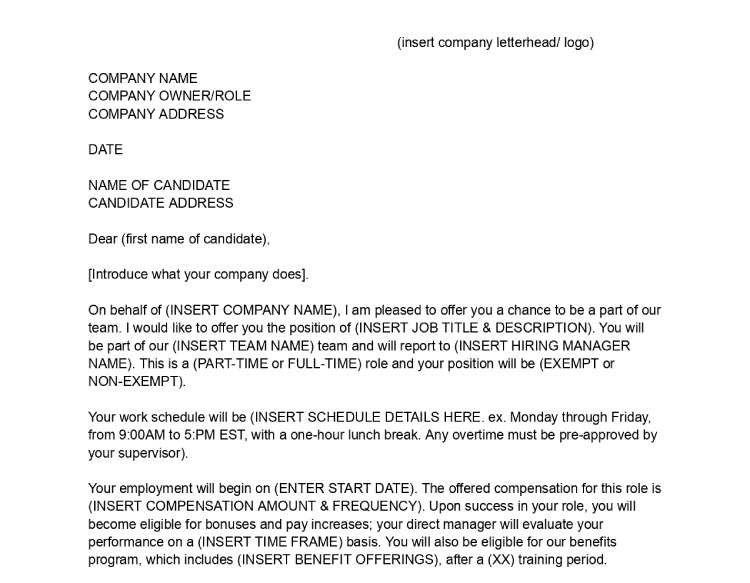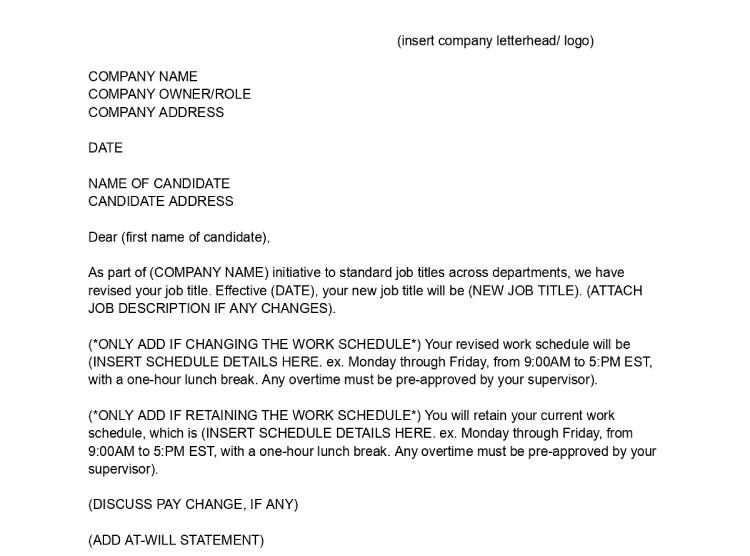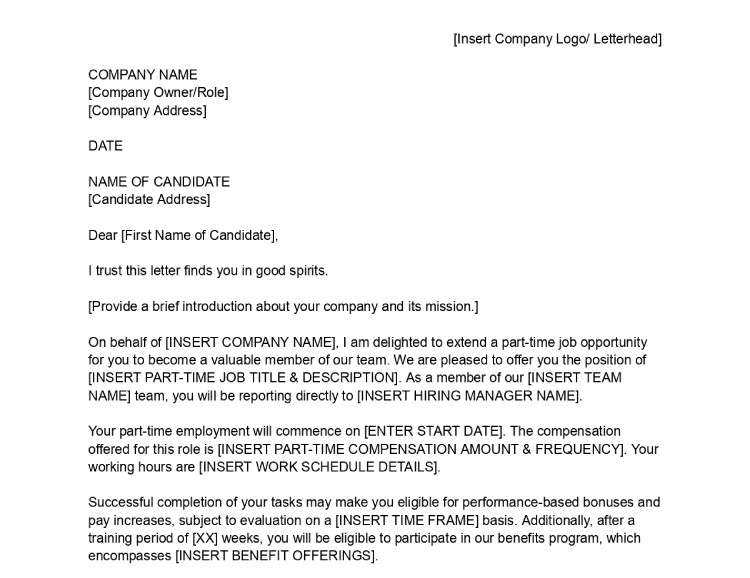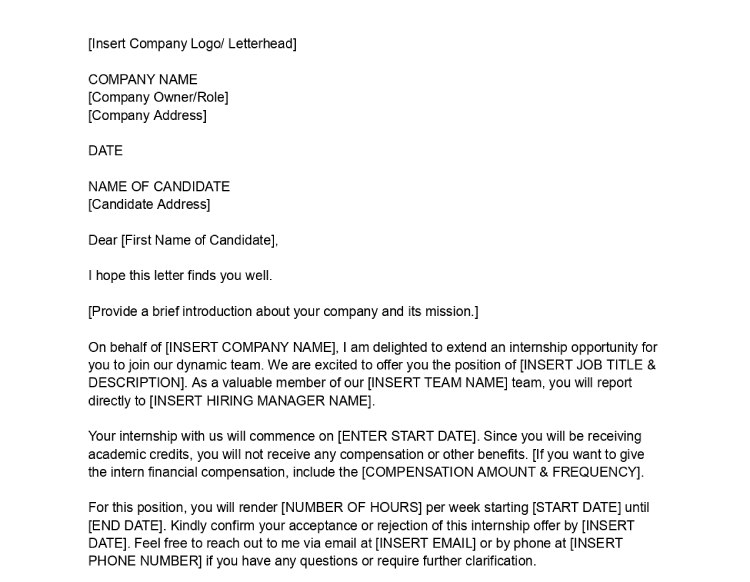An employment offer letter is a formal document from an employer outlining the terms and conditions of the proposed employment. It typically includes key details, like the job title, start date, salary, benefits, work location, employment status, and any special conditions or contingencies. While not as binding as a full employment contract, it serves as a written confirmation of the employment agreement and sets clear expectations for both parties.
I’ve created a standard offer letter template that you can download, personalize, and use to simplify the process of creating a job offer letter from scratch—it’s ideal for most permanent positions and new hires. I also created alternative job offer templates for internal promotions, job title changes, part-time job offers, internship offers, and role shifts after company acquisitions.
Alternative Job Offer Letter Templates
Internal Promotion Employment Offer Template
This template is specifically designed for existing employees moving to higher roles, detailing new responsibilities and updated compensation. It emphasizes the transition from a current role to a new position within the company.
Job Title Change Offer Letter Template
Use this template for employees transitioning to a new position. This template includes the new job title, responsibilities of the new position, and changes in compensation or benefits within the same company.
Part-time Job Offer Letter Template
This template is for positions with reduced hours and clearly states the work schedule and prorated benefits. It addresses specific terms, like hourly rates and schedule requirements.
Internship Offer Letter Template
This template is focused on temporary, learning-oriented positions with defined end dates and educational objectives. It includes mentorship details and performance evaluation criteria.
Acquired Company Job Offer Letter Template
This is a specialized template for welcoming employees transitioning during a merger or acquisition. It addresses retention terms, role continuity, and any changes to existing benefits or conditions.
Job Offer Letter Do’s and Dont’s
The job offer letter is a crucial document that sets the foundation for the employer-employee relationship. When done wrong, it can lead to misunderstandings, legal issues, and damaged relationships. As such, it’s crucial to specify all details, secure the necessary approvals, double-check the content, and have it checked with your legal counsel.
Here are a few do’s and don’ts to ensure your job offer letter is created completely, efficiently, and compliantly.
What a Good Job Offer Letter Should Include
A job offer letter is more than just a formal document—it’s your first opportunity to welcome a new employee to your company and clearly lay out what you’re bringing to the table. Let me walk you through what I would include in an offer letter and why each element matters for building a strong working relationship.
- Basic employment information
- Compensation package
- Benefits details
- At-will statement
- Working arrangements
- Offer period
- Method of acceptance
- Contingencies
- Additional terms
- Disclaimer
The employee’s title, where and when they will be working, and who they will report to aren’t just details—they’re the framework for the employee’s position within your organization. It should also clearly state the employee’s start date, so they can start their journey with us on the right foot.
You should outline the base salary, payment schedule, and any performance bonuses the employee can earn. If you’re offering equity, explain the terms clearly—not doing so can lead to immediate distrust and result in the candidate declining the offer.
A job’s benefits package is, in many cases, just as important to candidates as the salary.
Thus, you need to detail each benefit—from comprehensive health coverage to retirement planning—in the job offer letter. It should also include enrollment deadlines so the employee can take advantage of these benefits from day one.
Where applicable, you can include general information about benefits in the offer letter, such as:
- Insurance coverage
- 401(k) plan
- Paid time off
- Flexible spending accounts
- Educational assistance
- Flexible work schedule
- Work-from-home option
Many employers choose to reserve this language for the employment agreement. While it might seem less welcoming than the other parts of the offer, being upfront with the candidate that either party can end the employment relationship at any time builds trust through transparency and prevents costly misunderstandings.
Adding an at-will statement to your job offer letter:
Including an at-will statement legally protects both parties—employer and employee—by clearly establishing that both parties can terminate the employment relationship at any time, for any legal reason. This transparency helps prevent future misunderstandings and potential legal disputes about the nature of the employment relationship.
Check out our comprehensive guide on at-will employment for small businesses to understand your rights and responsibilities as an employer.
You should be upfront about work schedules and location policies. Whether it’s hybrid, remote, or in-office work, you should spell out your expectations clearly. If travel is required, you should detail the scope because it shows that you respect the employee’s time and want them to plan accordingly.
Offer periods are important because they give candidates time to consider the job offer, discuss it with family members, and compare it with competing offers. This gives the candidate reasonable time to consider the offer while allowing you to maintain an efficient hiring process. Typically, offer periods are between three to five business days—but you can always choose a period that makes sense for the role and hiring timeline.
In addition to letting candidates know how long they have to accept an offer, provide details about how they should accept or decline the offer. Including this information in the offer letter gives your potential employee a sense of confidence and security around the acceptance process while ensuring you don’t miss their response. Regardless of how you prefer candidates respond, always provide the relevant contact information, whether it be your phone number or email address.
It sets clear expectations for the candidate from the get-go. This list should include requirements like drug tests, background checks, and credit reviews. Being upfront about contingencies gives you legal protection, such as:
- Protects your offer if disqualifying information is discovered
- Gives you legal grounds to withdraw the offer if conditions aren’t met
- Establishes documentation for compliance with industry regulations
If there are contingencies, you should also include information about the next steps and whether you require any immediate action from the candidate. Failing to list contingencies in an offer letter could make it difficult to withdraw the offer if the candidate does not pass your initial requirements.
In this section, legal elements like confidentiality agreements are included because protecting the company’s interests also protects our employees. This should be presented in straightforward terms because mutual understanding is crucial for a strong professional relationship.
Finally, include a section in the offer letter explaining that the letter does not serve as a binding employment contract. It is also a good idea to include an equal opportunity employer statement. An attorney can help you draft this portion of the letter and review the offer in its entirety to ensure you’re not including any contractual language.
Employment Offer Letter Frequently Asked Questions (FAQs)
Send an offer letter immediately after making the verbal offer and receiving initial acceptance from the candidate—typically within 24 to 48 hours. You can email the letter as a PDF attachment (with company letterhead) to maintain professionalism, although giving a physical letter in person is also a common practice. Include clear instructions for accepting the offer, required response timelines, and who to contact with any questions. Most importantly, ensure all stakeholders (HR, hiring manager, legal if needed) have reviewed and approved the letter before sending it to prevent any errors or omissions that could cause legal issues.
After sending an offer letter, follow up with the candidate within 24 to 48 hours to confirm receipt and answer any questions they may have. While waiting for their response, keep your other candidates warm without making promises, and prepare onboarding materials so you can move quickly once the offer is accepted.
If this happens, remain professional and thank them for their time while asking for constructive feedback about their decision—the information can be invaluable for improving future offers. Consider reaching out to your second-choice candidate if they are still a strong fit, or revisit your hiring strategy to determine if you need to adjust your compensation package or job requirement.
Yes—but it is not a contract. While both documents require the candidate’s signature and yours, a contract is a more formal employment document, laying out complete details of the role and responsibilities, including the employment period. In contrast, an offer letter includes details of the role, but with brevity and without an obligation of time.
Yes—if an offer has not been accepted, you can revoke the offer at any time. If the offer has been accepted, you can still revoke the offer, but you may need a qualifying reason to do so, like the failure of a background screen as noted in the offer letter.
No. A job letter is an initial proposal outlining basic employment terms, like salary and start date, while maintaining flexibility for changes. On the other hand, an employment contract is a detailed, legally binding document that specifies comprehensive terms and obligations for both parties. While offer letters can be modified, contracts are more rigid and provide stronger legal protection once signed.





